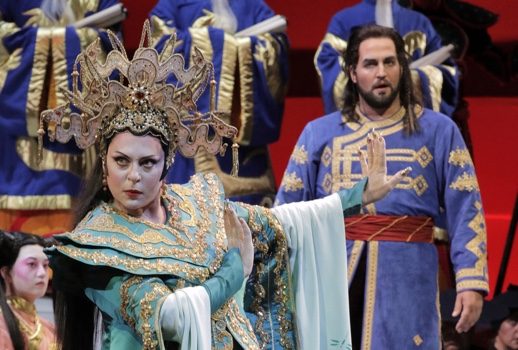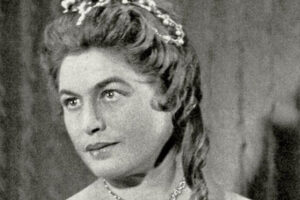

Brian Jagde (right) prepares to talk to the hand of Martina Serafin.
On Friday night, I had the pleasure of attending the season-opening performance of Turandot at San Francisco Opera, directed by Garnett Bruce and conducted by Nicola Luisotti. I had been looking forward to this performance for a while, not only for its daring score—equal parts Puccinian schmaltz, nineteenth century “oriental” musical topics, and hard-edged machine-age dissonances—but also to see what the Opera would be able to do with Turandot’s strange personalities and plot.
In the wrong hands, leads Turandot and Calaf are two deeply unlovable characters—the former a dishonest and unfeeling femme fatale and the latter a glory-obsessed youth—neither having any regard for the suffering they inflict on others to get their way.
The opera’s final duet (completed, incidentally, not by Puccini but posthumously by Franco Alfano) strains credulity at the best of times. It requires masterful directing and performance to make the opera’s abrupt five-minute denouement—in which Calaf reveals his identity to Turandot and she reciprocates by giving herself all-at-once over to him—seem even remotely plausible.
By and large, SF Opera’s attempts to address these issues, both through casting and staging, hit the mark. The performance benefitted disproportionately, however, from two elements: a brilliant tenor performance by Brian Jagde, whose creative and charismatic inhabitation of his character was almost enough to make up for his counterpart Martina Serafin’s distant portrayal of Turandot; and excellent leadership from Music Director Nicola Luisotti in the orchestra pit.
The SF Opera Orchestra maintained the high bar for Puccini performance that it set in Madama Butterfly a year ago. Although both Turandot and Butterfly are “Eastern exoticist” pieces, they employ different musical languages. The China of Puccini’s fantasies in Turandot is a harsher world than that of Butterfly.
The music—full of spiky motivic cells and bracing dissonances—combines “Eastern” pentatonic motives, a few quotations of traditional Chinese melodies, and the urban sounds of post-World War I Europe to conjure a barbarous, ancient world. And while the more familiar Puccinian sound of Boheme and Butterfly is reserved for the opera’s most intimate moments, it takes a back seat to his newer, more experimental sound. Luisotti’s negotiation of this incongruous musical style was brilliant, managing to bring out the orchestra’s best in both the classic and the new Puccinian voice.
A heavy but never overbearing percussion battery and menacing low brass infused drama into Calaf’s completion of Turandot’s riddles, while Luisotti gave the more intimate arias space to blossom above a rich string sound. His leadership formed the foundation for a highly musical performance from the cast, Jagde chief among them.
After an auspicious performance of Radames in last year’s Aida, Jagde has clearly arrived as a world-class heroic tenor in this role debut as Calaf. The character of Calaf requires a certain amount of inventiveness from the singer. He is at once an impulsive, romantic, young man to whom Puccini accords all the musical warmth of his most sympathetic heroes, and a callous Don Juan, willing to watch a deeply devoted servant be tortured for her loyalty in order to accomplish his conquest of the princess.

Strutting across the stage in a way completely unbefitting a stranger in a strange land, Jagde presented Calaf as a flawed hero whose overconfidence and bravado could cause him, at worst, to abandon his humanity. His delight in the danger of defying every warning, pride in overcoming Turandot’s challenge, and infatuation with Turandot wove noble and ignoble passions together into an inseparable knot.
Like Calaf, the character of Turandot requires a dramatic balancing act in order to be credible. It is left up to the singer and the director to figure out how a woman with such a severe, steely commitment to chastity finds herself suddenly overcome by love at the end of the opera. But one thing is certain: if the imperious Turandot reaches the opera’s final duet having demonstrated up to that point no vulnerability whatsoever—not even the smallest crack in her hard exterior—her sudden conversion is doomed to be unconvincing.
And then, coming right on the heels of this empty fulfillment, the opera’s final choral celebration of the all-conquering power of love takes on the forced aspect of the final minute of Shostakovich’s Fifth Symphony, as the listener’s lingering doubts are ground beneath the authoritarian boot. These are dramatic problems that librettists Giuseppe Adami and Renato Simoni ought to have thought a bit harder about. But since they did not, twenty-first century stage directors and Turandots are left to find their own solutions.
Regrettably, in this production, they did not. Serafin’s tone and physical aspect evinced a cold detachment, beginning the moment she first entered the stage. Musically, her inflexible tone and taut, metallic vibrato kept the audience at arm’s length, and made me seriously concerned for Calaf’s sanity as he continued to pursue her.
The limited opportunities that Puccini and the librettists offered her character to show some humanity, fear, or remorse, she violently slammed shut. As Calaf answered her riddles correctly, Serafin gave no hint of the shaken reaction the situation demanded of her. And as she determinedly continued to refer to Calaf as “stranger” into the opera’s final scene, that epithet took on none of the painful, ironic aspect it needed.
Her icy tone was supplemented by a weird body language. Particularly noticeable was her tendency to make a “talk to the hand” motion in the opposite direction from the person she happened to be rebuking. She did this often enough that it rose to the level of a physical affectation. To be sure, technically speaking, Serafin was more than up to the task—she projected well over orchestral tuttis and accompanied Jagde with a practiced sense of pacing—but the absence of warmth in her tone and acting was impossible to ignore. Not even Turandot is that cold.
Musically speaking, Toni Marie Palmertree won a triumph in the character of Liu, the devoted slave girl who safeguards the secret of Calaf’s name even to the grave. Liu’s two solo arias, when well performed, provide a respite from the jagged landscape of harsh dissonances and pentatonic “Eastern” motives that pervades the rest of the opera.
Palmertree used these opportunities to great effect, stretching phrases with a rich, oboe-like soprano tone. Though her singing caused a greater degree of push-and-pull with the orchestra than that of Jagde or the other principals, Puccini’s stretchable orchestration allows for, and even encourages, such liberties.

The trio of Ping, Pang, and Pong, the foppish officers charged with guarding Turandot’s virtue and dissuading her suitors, was expertly played by Joo Won Kang, Julius Ahn, and Joel Sorensen. In their Shakespearean Fool roles, the three lurched amusingly between emotional states, in one moment wistfully recalling their lakeside homes left behind in their service of Turandot, and in the next indulging in macabre fantasies as they mimed the impending slitting of Calaf’s throat.
In an opera of strange moods and emotional disconnects, the trio always provided welcome comic relief. All three—and above all the baritone Kang—projected well over the orchestra and demonstrated taut and easily intelligible diction even against dense orchestral textures.
In the bass role of Timur, the deposed Tartary king and Calaf’s father, Raymond Aceto contributed a burnished tone and committed acting, at times making up for Palmertree’s less-involved dramatic performance.
As usual, Ian Robertson’s chorus was well-prepared for the production. Unlike most of Puccini, however, which well suits the SF Opera Chorus’ glowing, slow-to-develop tone, Turandot contains several scenes which demand a more abrasive choral approach. The first scene, for instance, in which the chorus witnesses the beheading of the Prince of Persia, requires incisive articulation and explosive consonants—that is, at least, if the production wants to get us to take the situation seriously.
With the more laid-back, beautiful sound of this choir, however, this nineteenth century scene of “Eastern barbarity through European eyes” felt more comic than tragic. In the nocturnal scene of the third act, however, when Puccini’s score requires a choral sound so light as to seem suspended in the air, the chorus demonstrated the same effortless sound and impeccable phrasing that they did in Madama Butterfly last year.
The expectant choral prelude to Turandot’s arrival in the second act was another highlight (if there was anything in this production that might explain Calaf’s inexplicable infatuation with the princess, it could be the intoxicating atmosphere that the chorus created to precede her onto the stage).
Turandot’s staging, set design, and costuming added to the atmosphere created by the ensemble, and compensated somewhat where the singers on stage fell short. Many of Ian Falconer’s costumes and scenes recalled the whimsical landscape of Butterfly—particularly Ping, Pang, and Pong’s bright, many-layered polka-dot costumes.
He also, however, established a darker aesthetic for the early large ensemble scenes, dressing the chorus entirely in black. The production also benefitted from Thomas Munn and Gary Marder’s creative lighting designs. One particularly effective example was the dusky glow they managed to conjure for the chorus’ invocation of the moon.
Overall, Turandot was an ambitious and mostly successful start to SF Opera’s year—one particularly exciting for Jagde’s brilliant (and sure to be repeated elsewhere) performance as Calaf, and Luisotti and the SF Opera Orchestra’s continued mastery of the Italian repertoire.
Photos: Cory Weaver/San Francisco Opera
























Comments